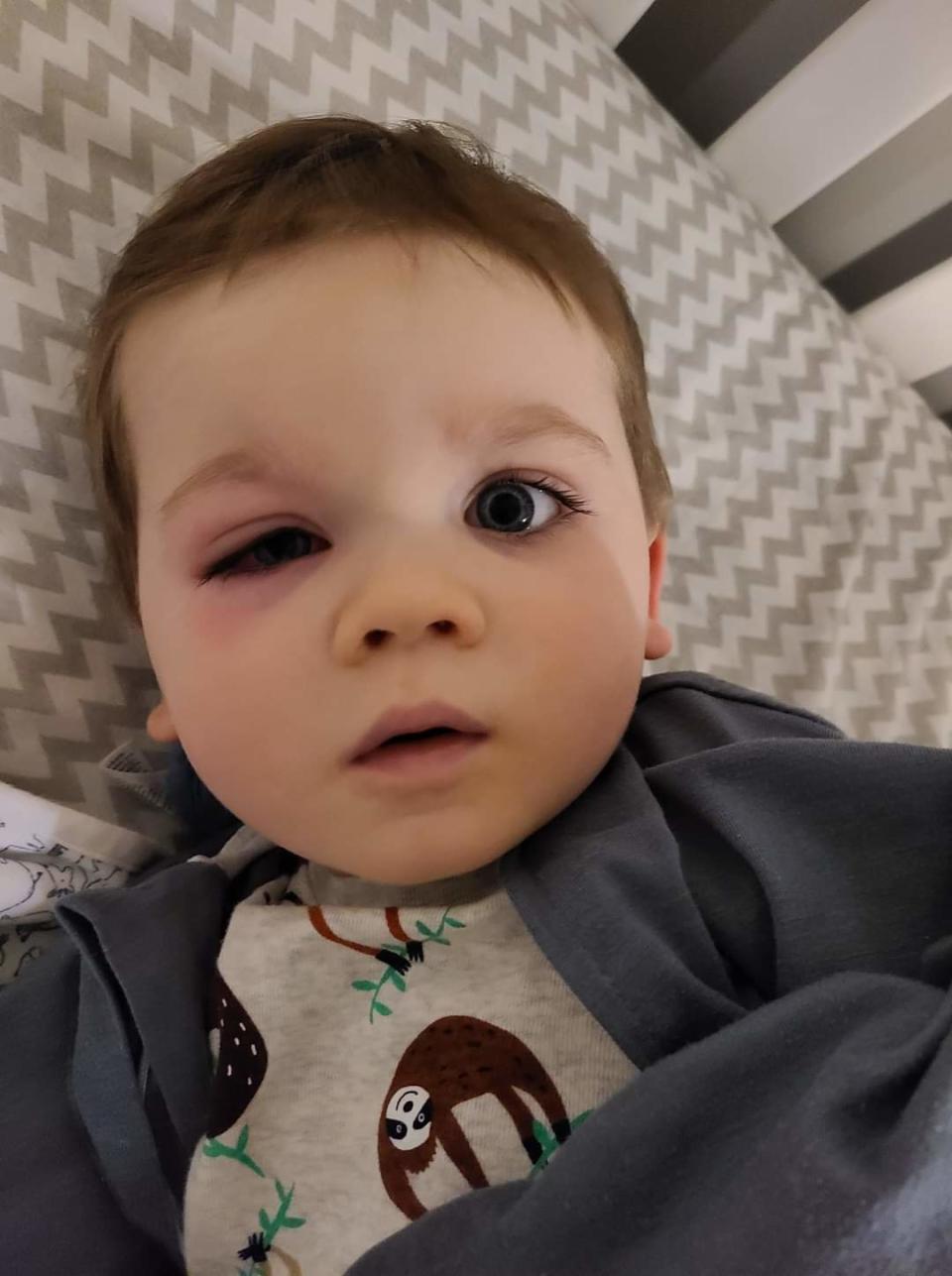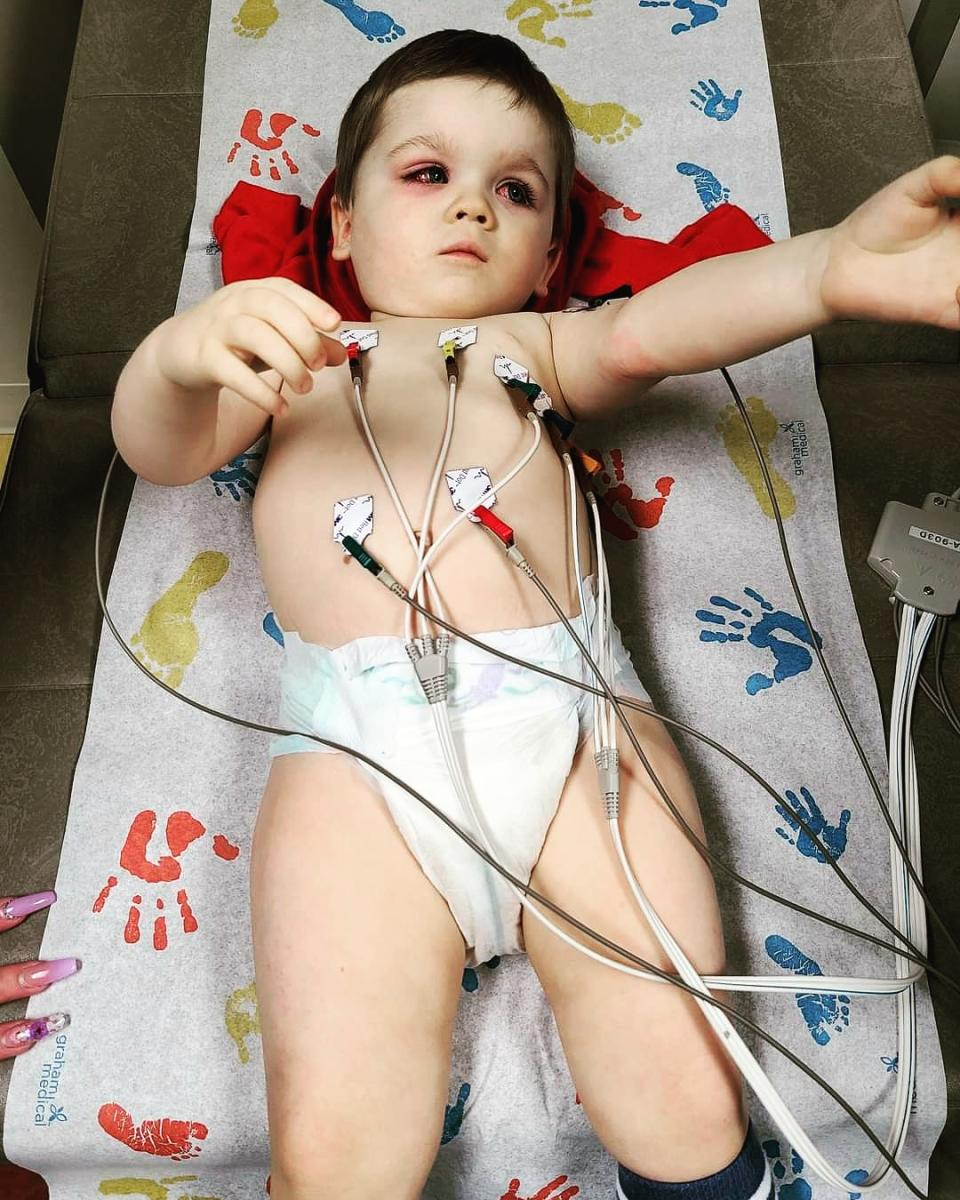My son nearly lost his vision after an eye infection. Here's why you should be 'aware of the hidden dangers' lurking in bath toys

I wasn’t prepared for what I saw when I walked into my 2-year-old son’s room one morning in March: his eye, swollen beyond recognition, just 12 hours after his bath, when he had squirted himself in the eye with water from a squeezable rubber duck toy. In shock, all I could do was yell down the stairs to my husband to call 911 or help me get my son into the car quickly.
The squirting was an innocent action he’d done many times before, but this time his eye had begun to look a bit infected. Not thinking much of it, we had taken him to an urgent care clinic and left armed with a diagnosis of pink eye and a prescription for eye drops, hoping the infection cleared up soon. But almost immediately, it began to get worse, and by midnight he was in the emergency room with a diagnosis of cellulitis and we went home with a prescription for strong oral antibiotics. But by morning, we were rushing him to the hospital with a raging fever, praying he wouldn’t lose his now grossly disfigured eye.

It was there that we learned he was at risk for not only losing his vision but, should the infection spread to his brain, he could lose much more than his eyesight. Thankfully, after IV antibiotics, a CT scan to check for retinal damage, and specialized follow-up care, we were blessed that he pulled through with his vision intact.
Yet although my son has healed well, I’ve never been able to shake the feeling that other parents need to be aware of the hidden dangers some tub toys pose. I had cleaned that specific toy often, always squeezing the water out and checking for mold. Even the day he got sick, the toy looked clean when I held it up to the light; a fact I just couldn’t wrap my head around.
I posted a warning on Facebook on Sept. 21 and within days, the post had gone viral, garnering 60,000 comments, nearly 50,000 reactions and more than 259,000 shares. News outlets from all across the U.S., Germany, Scotland, England, Australia, and more have asked to interview me and publish my son’s photos.
But the most surprising response in all of this has been this: the enormous amount of messages from other parents whose children went through the same thing as my boy.
“Hi Eden,” read a message from Shante Overly of Milford, Conn. “I wanted to let you know that the same thing happened to my son two years ago.” Sharing a picture of her son sitting on a hospital gurney with a severely swollen eye, it was heart-wrenching to realize that other children had already experienced the same thing.
Antoinette Nicchia-Howe from Cape Coral, Fla., went so far as to send me a video of the tub toy she had cut open. “I NEVER would have thought to check my son’s bath toys!! Welp! Broke one open today and it was filled with mold!! I clean them constantly with boiling hot water and soap and squeeze it and squirt it out and put them upside down to dry. I thought I was doing everything I could to make sure they were clean!”
Thankfully her child had not yet gotten sick from his toys, but it made me wonder, how often is this happening?

Taking my question to Google, I learned that in 1998, a bacteria associated with significant morbidity and mortality rates in newborns and immunocompromised children was found to be colonized in bath toys given to children in the hospital, and had resulted in a number of children being infected.
Wondering if the same bacteria could affect children outside of a hospital setting, I reached out to Frederick Hammes, a Swiss microbiologist from the Institute of Aquatic Science and Technology who led a 2018 research study that involved cutting open rubber ducks and testing what was inside. What the researchers found was that 80 percent of the ducks they tested contained bacteria including E. coli, legionella, and pseudomonas aeruginosa — as many as 20 million cells per square centimeter, to be exact.
Although his background is in microbial ecology and not health, Hammes suspects that “one of the reasons why you don’t hear many nasty stories about toy-related contamination is that it would usually result in relatively minor ear/eye infections, which are often relatively easily treated and then forgotten.” Which would mean that many children have quite possibly already contracted a tub toy infection, but their parents didn’t even realize where the infection originated from.

“Bacterial biofilms are unfortunately not visible to the naked eye,” he explained to me. “The design of the squeezable toys with a water hole means you always have a bit of water remaining in the toy, which gives enough humidity for bacteria, and certainly for fungi, to grow.”
This is where Hammes believes “support from manufacturers to minimize any adverse effects is certainly helpful,” saying that “this can be in the form of a [warning] label, but it can also be an improvement of how the toys are made, and which materials are used to make them.”
If you’re a parent who is worried, one solution might be to simply throw away your squeezable tub toys.
"There are nice bath toys without the hole drawing in water,” adds Hammes, “which is clearly a better choice."
Read more from Yahoo Life
Coronavirus detected in lake water, researchers find. Experts say don't panic.
Here's how the CDC says you can celebrate Thanksgiving safely
Want daily lifestyle and wellness news delivered to your inbox? Sign up here for Yahoo Life’s newsletter.
